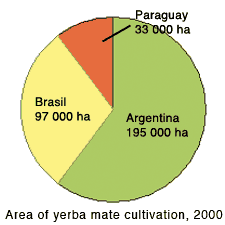The natural habitat of yerba mate, as well as the area under cultivation is, roughly, limited to the west by the Paraguay river, to the east by the Atlantic Ocean, to the north by the 18th parallel of south latitude and to the south by 30th parallel of south latitude. Efforts to cultivate yerba mate in regions of similar climate in North America, Asia or Africa have not succeeded yet.

The plant needs at least 1500 mm of rainfall per year, an average monthly temperature between 15,5 and 28°C. It is able to survive short‑term temperature falls to -8°C.
It grows mainly on sandy-clayey and clayey-sandy soils, rich in phosphorus, potassium, iron, developed on permeable subsoil.
Almost 80% of the area of occurrence is located on the territory of Brazil, mainly in the following states: Paraná, Santa Catarina, Rio Grande do Sul, and also: São Paulo, Mato Grosso do Sul and Minas Gerais. Most of yerba mate leaves used for production in this country is harvested from wild growing trees. However in recent years the area under cultivation has been growing. In Argentina top ranks in terms of the quantity of production belong to two provinces: Misiones (more then 85% of the country total production) and Corrientes. Those provinces are also main area of yerba mate processing industry. Yet a few big companies are located in Buenos Aires.
The biggest producers — Argentina, Brazil and Paraguay are at the same time the biggest consumers. In Brazil most consumers live in the area of production, while in Argentina and Paraguay it is consumed all over the country. Other yerba mate consuming countries in South America are Uruguay, Chile and Bolivia. Another important region of yerba mate drinking in the world is Middle East, mainly Syria and Lebanon. The habit of drinking yerba mate came to this region with emigrants returning from South America. Syria is world's biggest importer of yerba mate.


沒有留言:
張貼留言